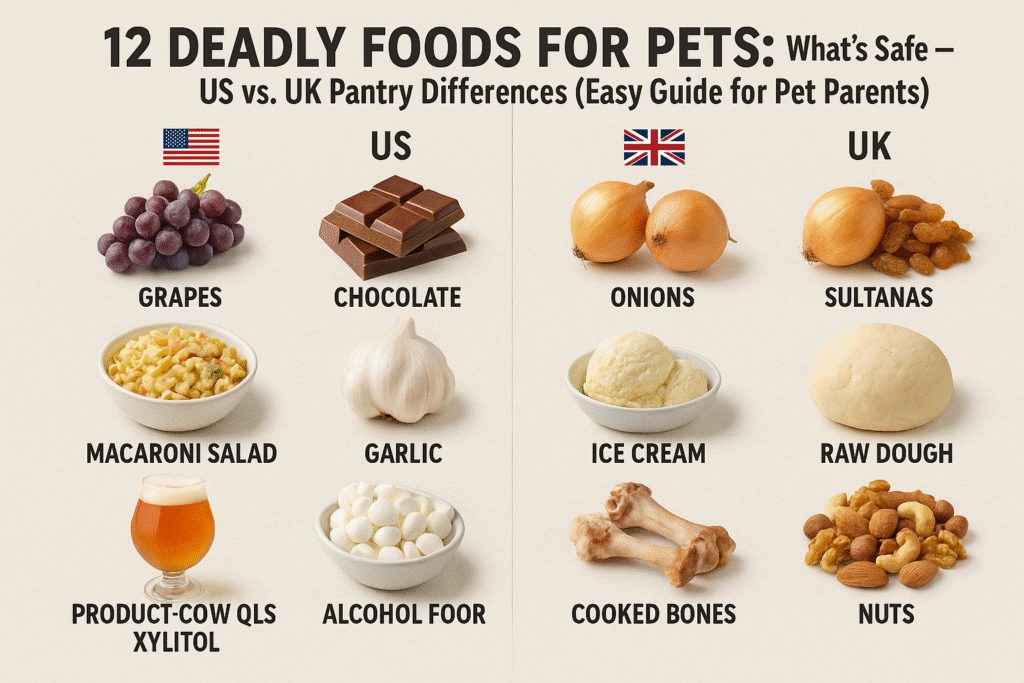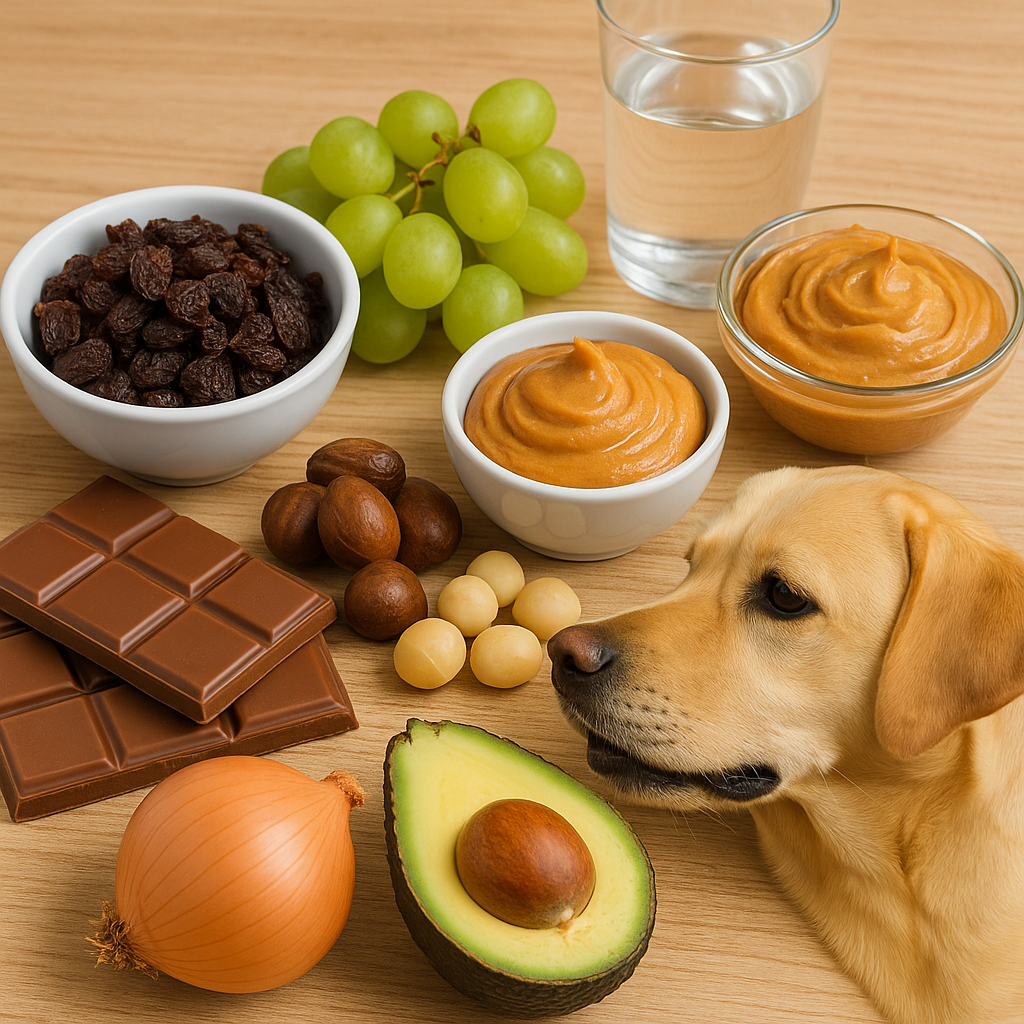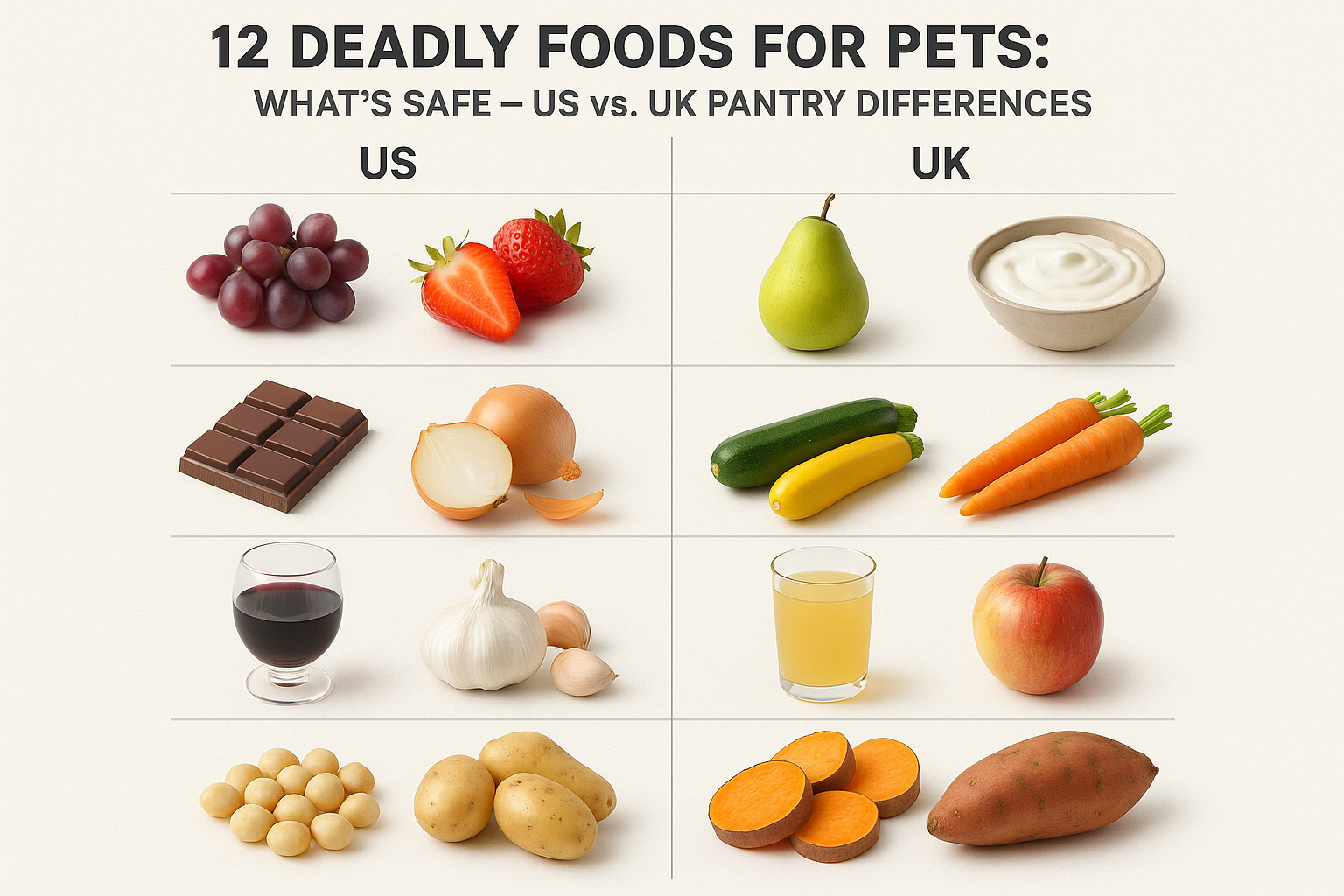Those innocent-looking leftovers on your counter can be dangerous—or even deadly—to pets. Whether you live in the US, the UK, or anywhere else, it helps to know which common human foods pose the biggest risks and how to act fast if your curious dog or cat gets into the pantry. This friendly, step-by-step guide explains the top Deadly Foods for Pets, highlights small differences between the US and UK (packaging, product types, and regulatory warnings), and gives practical DIY safety tips you can use today.
Quick safety rules (read first)
- If you suspect your pet ate something toxic, call your veterinarian or an animal poison control line right away—do not wait for symptoms to appear. (ASPCA, Pet Poison Helpline)
- Don’t induce vomiting unless a veterinary professional tells you to—some substances do more harm coming back up. (Pet Poison Helpline)
- Note the product name, ingredients list, and approximate amount eaten — that information helps the vet make fast decisions. (Pet Poison Helpline)
Why US vs. UK matter: small but important differences
Most toxic foods are the same worldwide, but there are practical differences that matter for pet owners:
- Labeling & additives — Some sweeteners (like xylitol) are widely used in sugar-free gums and peanut butters in the US and increasingly in the UK. Always check ingredient lists for “xylitol,” “birch sugar,” or other aliases. The FDA and UK vet charities both warn that xylitol is extremely dangerous to dogs. (U.S. Food and Drug Administration, PDSA)
- Product types in pantries — In the US you may see more sugar-free peanut butter brands and gum varieties on store shelves; in the UK there may be different sugar-replacement labeling or region-specific snacks. The bottom line: read labels everywhere. (U.S. Food and Drug Administration, PDSA)
- Regulatory alerts — The US FDA issues advice on pet-product outbreaks (eg. jerky treats); in the UK the Food Standards Agency and Veterinary Medicines Directorate issue recalls and warnings (eg. dog chews). Check local government pages for product alerts. (U.S. Food and Drug Administration, Food Standards Agency)

The 12 Deadly Foods for Pets (what they do and what to do)
1. Xylitol (sugar substitute) — extremely dangerous to dogs
Where it’s found: sugar-free gum, mints, some peanut butters, baked goods, certain medicines, and some “healthy” snack bars.
Why it’s dangerous: xylitol causes a sudden surge of insulin in dogs → severe hypoglycaemia (low blood sugar) and can cause acute liver failure. Signs may start within 20 minutes and include vomiting, weakness, collapse, tremors, seizures. (U.S. Food and Drug Administration)
What to do: Call your vet or poison control immediately. Bring packaging to the clinic. Don’t try home remedies—time matters. (Pet Poison Helpline)
2. Chocolate & cocoa — dose-dependent and common
Where it’s found: baked goods, candy bars, cocoa powder, hot chocolate. Dark chocolate and cocoa powder are more dangerous than milk chocolate because they contain higher levels of theobromine and caffeine. Dogs and cats metabolize these stimulants poorly, and toxicity can cause vomiting, diarrhoea, restlessness, rapid heart rate, tremors, seizures and even death. (ASPCA, U.S. Food and Drug Administration)
What to do: Note the type/amount of chocolate and pet’s weight; call your vet or pet poison hotline. Some cases need activated charcoal or hospitalisation.
3. Grapes, raisins, sultanas, currants — unpredictably toxic to dogs
Where it’s found: fruit bowls, trail mixes, baked goods (e.g., hot cross buns), leftover fruit.
Why it’s dangerous: even small amounts can cause acute kidney injury in some dogs; the exact toxin is unknown, and sensitivity varies by animal. Seek treatment immediately. (ASPCA, Pet Poison Helpline)
What to do: Emergency vet visit—early treatment improves outcomes.
4. Onions, garlic, leeks, chives (allium family) — blood-cell damage
Where it’s found: cooked meals, gravies, soups, some baby food.
Why it’s dangerous: these foods can cause oxidative damage to red blood cells (hemolytic anemia) in dogs and cats; signs include weakness, pale gums, rapid breathing, and dark urine. Toxicity can occur from a single large exposure or repeated small amounts. (PDSA, PMC)
What to do: Call your vet quickly—treatment may include activated charcoal, fluids, and supportive care.
5. Macadamia nuts — dogs are sensitive
Where it’s found: cookies, desserts, nut mixes.
Why it’s dangerous: macadamia nuts can cause transient weakness, tremors, vomiting and hyperthermia in dogs. The exact toxin is unknown but effects usually show within 12 hours. (ASPCA)
What to do: Contact your vet—most dogs recover with supportive care but monitoring is essential.
6. Alcohol & raw bread dough — rapid, dangerous effects
Where it’s found: alcoholic drinks, unbaked dough, fermenting fruit.
Why it’s dangerous: alcohol causes depression of the central nervous system and can lead to vomiting, breathing problems, coma, and death. Raw dough continues to ferment in the stomach producing alcohol and also expands, causing pain and potential bowel obstruction. (U.S. Food and Drug Administration)
What to do: Emergency care—do not wait.
7. Salt & salty snacks — seizure and dehydration risk
Where it’s found: chips, pretzels, salted nuts, table salt.
Why it’s dangerous: large salt ingestion can cause sodium ion poisoning → excessive thirst, vomiting, diarrhoea, tremors, seizures and neurological signs. (U.S. Food and Drug Administration)
What to do: Call a vet; severe cases need IV fluids and monitoring.
8. Avocado — species-dependent risk
Where it’s found: guacamole, avocado slices, baking ingredients.
Why it’s dangerous: avocado contains persin, which can be toxic to birds, some large animals, and possibly cause stomach upset in dogs and cats; high-fat avocado can also cause pancreatitis in dogs if eaten in large quantities. Use caution and avoid feeding pets avocado flesh or pit. (ASPCA)
What to do: Contact your vet if ingestion is large or pet becomes unwell.
9. Caffeine (coffee, tea, energy drinks) — stimulant hazard
Where it’s found: coffee grounds, energy drinks, strong tea.
Why it’s dangerous: caffeine causes hyperactivity, high heart rate, tremors and seizures in pets. Even small amounts of concentrated forms (grounds, espresso) can be risky. (ASPCA)
What to do: Quick call to vet or poison line.
10. Certain nuts & seeds (e.g., macadamia, excessive fat) — pancreatitis risk
Where it’s found: many baked goods and snack mixes.
Why it’s dangerous: high-fat foods can trigger pancreatitis in dogs. Macadamia nuts (see #5) have additional direct effects. (PMC)
What to do: Monitor appetite and stool; call vet for guidance.
11. Some human medications & supplements — often fatal to pets
Where it’s found: medicine cabinets, purses, countertops.
Why it’s dangerous: human painkillers (ibuprofen, acetaminophen), antidepressants, ADHD meds and some supplements can be life-threatening to pets; cats are particularly susceptible to acetaminophen. Keep all meds secured. (U.S. Food and Drug Administration)
What to do: Immediate veterinary attention—bring pill bottle/label.
12. Problematic pet treats & imported chews — recalls and contamination
Where it’s found: some jerky treats and foreign treats have been linked to illness; regulatory bodies occasionally issue recalls. The FDA and FSA have issued alerts about jerky treats and dangerous imported chews; the UK FSA has warned about specific dog chews linked to illness. Check product recalls regularly. (U.S. Food and Drug Administration, Food Standards Agency)
What to do: Stop feeding recalled products and consult your vet if your pet shows changes in behaviour, appetite, or stool.

How to spot poisoning — common early signs
- Vomiting and/or diarrhoea
- Lethargy, weakness, wobbliness or staggering
- Tremors or seizures
- Rapid breathing or abnormal heart rate
- Pale or very red gums, drooling, or signs of abdominal pain
If you see any of these after suspected ingestion, act quickly—call your vet, Pet Poison Helpline, or ASPCA Poison Control. (Pet Poison Helpline, ASPCA)
Pantry-proofing: DIY tips that actually work
- Make “no-go” zones: Keep counters clear, use childproof latches on low cupboards, and close pantry doors. Curious pets are excellent climbers.
- Label check ritual: Before using peanut butter, gum, or a sugar-free product, get in the habit of scanning the ingredients for “xylitol” or “birch sugar.” Put a small red sticker on anything containing xylitol so everyone in the house knows. (U.S. Food and Drug Administration)
- Secure trash & compost: Use lidded bins and keep compost out of reach—many foods that are safe in small amounts become dangerous after fermentation or concentrated exposure.
- Swap risky snacks: Replace chocolate and candy bowls with pet-safe treats or fruit placed out of reach. For holiday seasons (Easter, Thanksgiving), store baking goods and candy in high cupboards. (ASPCA)
- Emergency kit: Keep a photo of your pet, their weight, the vet’s number, and phone numbers for ASPCA (US) and Pet Poison Helpline where you can find them quickly. Also keep an emergency carrier or leash handy. (ASPCA, Pet Poison Helpline)
What to do now if your pet ate something dangerous
- Stay calm and move the pet to a safe area.
- Identify the item and how much was eaten—save packaging.
- Call your vet or an animal poison control centre right away (ASPCA, Pet Poison Helpline, or local emergency clinic). Do not induce vomiting unless a professional instructs you to. (ASPCA, Pet Poison Helpline)
- If advised to take your pet to the clinic, bring the packaging and a precise time estimate of ingestion. Quick action saves lives.
Useful official resources & hotlines (clickable)
- ASPCA – People Foods to Avoid Feeding Your Pets. A concise list and urgent contact: https://www.aspca.org/pet-care/aspca-poison-control/people-foods-avoid-feeding-your-pets. (ASPCA)
- FDA – Xylitol and Dogs (consumer guidance): https://www.fda.gov/consumers/consumer-updates/paws-xylitol-its-dangerous-dogs. (U.S. Food and Drug Administration)
- Pet Poison Helpline (24/7) — advice and emergency help: https://www.petpoisonhelpline.com/ (phone numbers available on site). (Pet Poison Helpline)
- PDSA (UK) – Poisons and Hazards for Your Pets: https://www.pdsa.org.uk/pet-help-and-advice/looking-after-your-pet/all-pets/poisons-and-hazards-for-your-pets. (PDSA)
- RSPCA – Food Safety & Pet Poisons (UK): https://www.rspca.org.uk/adviceandwelfare/pets/cats/behaviour (search their “poisons” pages). (rspca-radcliffe.org.uk)
- UK Food Standards Agency – Pet food warnings & dog chew alerts: https://www.food.gov.uk/news-alerts/news/precautionary-advice-issued-to-pet-owners-on-dog-chews-linked-to-illness. (Food Standards Agency)
- FDA – Pet treat & jerky advisories: https://www.fda.gov/animal-veterinary/outbreaks-and-advisories/fda-investigates-animal-illnesses-linked-jerky-pet-treats. (U.S. Food and Drug Administration)
Final checklist — keep this handy
- Remove or secure xylitol-containing items; label any household products that contain it. (U.S. Food and Drug Administration)
- Keep chocolate, grapes/raisins, onions/garlic, and macadamia nuts well out of reach. (ASPCA, Pet Poison Helpline)
- Use sealed bins for trash and compost.
- Post emergency numbers (vet, ASPCA, Pet Poison Helpline) on the fridge. (ASPCA, Pet Poison Helpline)
- Check pantry labels before feeding human food to pets — and when in doubt, don’t feed.
Quick takeaway
Most pet poisonings are preventable with a little pantry awareness and quick action. The most dangerous items to keep out of paw-reach are xylitol, chocolate, grapes/raisins, onion/garlic, and high-fat foods — but there are others worth knowing. If you suspect ingestion, call your vet or a poison control line immediately—packaging and timing are key details that help save lives. (U.S. Food and Drug Administration, ASPCA, Pet Poison Helpline)
Disclaimer: This article is educational only and does not replace professional veterinary advice. If you suspect your pet has ingested a toxic substance, contact your veterinarian, the ASPCA Poison Control Center (US) or Pet Poison Helpline (international) immediately. All images used in this article are royalty‑free or licensed for commercial use and are provided here for illustrative purposes.
